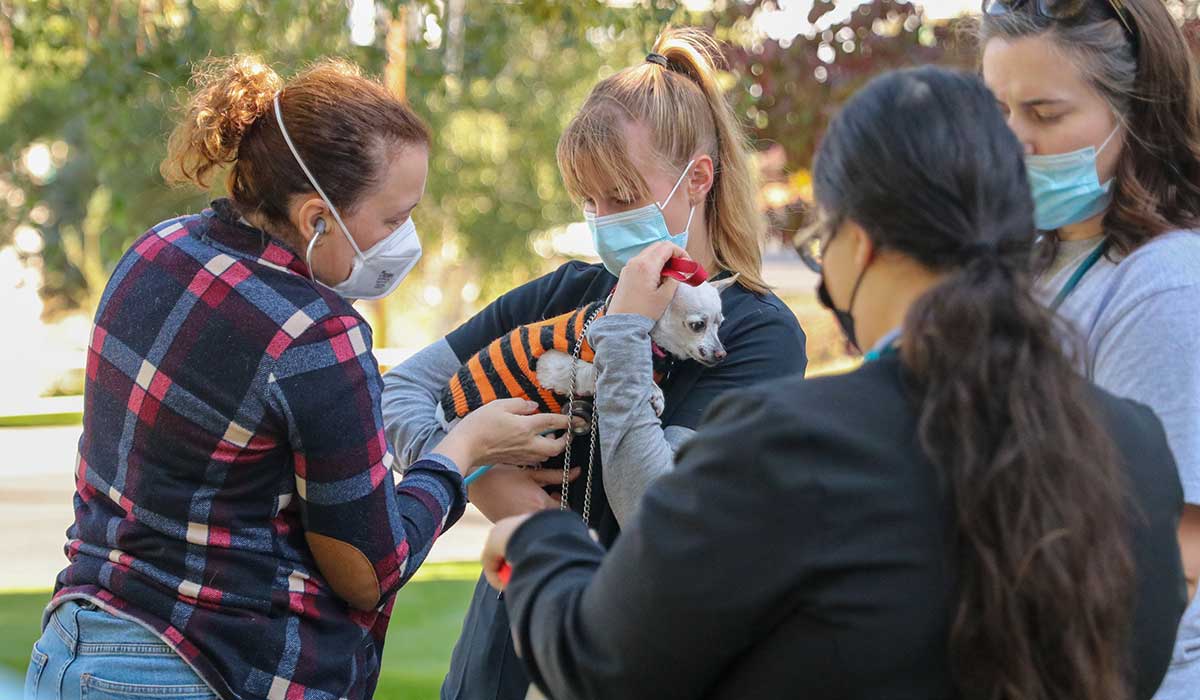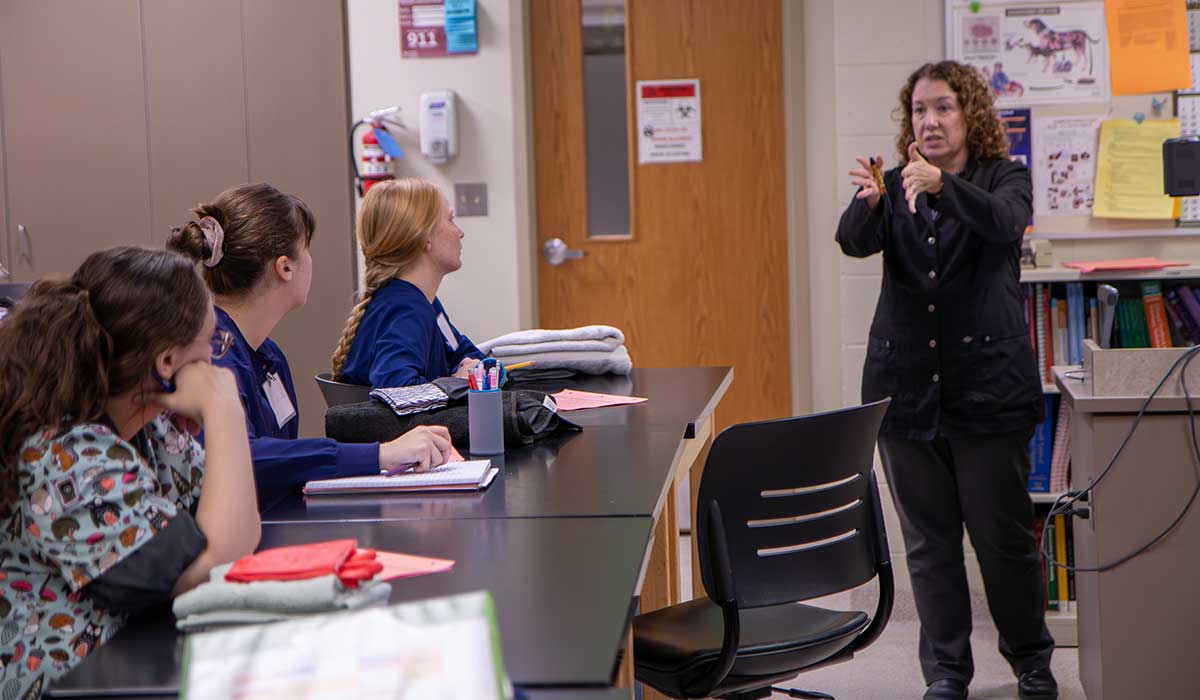Before adopting any pet, whether furry, feathered or finned, it's crucial to carefully consider several factors to ensure a harmonious and fulfilling relationship. From lifestyle compatibility to financial readiness, these tips will help you make an informed decision and set your pet up for success.
Joanna Fischer, director and instructor for Yakima Valley College’s Veterinary Technology Program, has more than two decades of experience in animal care. Fischer, who is from Western Washington, graduated from Washington State University in 2000 and began practice at the Selah Veterinary Hospital. In 2006, she joined the staff at Pet Health Clinic in Sunnyside, where she worked until joining the YVC’s faculty full-time in fall 2022 after working as an adjunct instructor for a couple of quarters.
In this installment of “Ask the Expert,” Fischer shares some simple tips for what to consider when considering adopting a pet.
For someone considering adopting a new pet what are some basic steps they should take before deciding?
Before adopting a pet people need to consider the following factors:
- Will the pet be strictly for companionship, or will it be a working animal? Will it have functions like herding, disability service, breeding, guarding your home or livestock?
- Some pets need significant owner interaction, others need a lot of exercise or a job, some pets need regular grooming, and others have very specific living space needs such as small mammals, reptiles and birds. People should ask themselves if their lifestyle will be appropriate for the pet at a young age, when fully grown and into its golden years.
- An owner also needs to know the expected life span of the pet. Re-homing pets is difficult and often results in neglect or harm to the animal. If you have the time, space and lifestyle for a particular pet now, will you have those same conditions for the expected life of the pet?
For those considering several different animal breeds what recommendations do you have to help them learn more about which breed would fit best with their lifestyle?
If looking at dogs, the American Kennel Club offers basic descriptions of different breeds. This is a good place to start. At the bottom of the breed pages there are often links to breed specific organizations that provide more detail and can even speak to the challenges with the breed that may cause a poor match with an uneducated or unsuspecting owner. For cats, a similar organization is The International Cat Association.
For small mammals, reptiles, fish, birds and amphibians it’s more of a challenge to find the right information. There are some very good species-specific online owner forums, but there are also some very bad ones. These species are often subject to severe neglect and welfare problems because owners are unfamiliar with their very specific needs. Information on these species is often outdated as well.
It is the owner/keeper's responsibility to provide an environment and diet that mimics natural conditions as much as possible. It is very important to find expert advice. Look for people with many years of experience in breeding, raising and studying the species. Raising one or two animals does not make someone an expert.
What tips do you have for people to prepare financially for welcoming a new pet into their lives?
The cost of owning a pet does not end at the purchase price. Different types and breeds of pets have different medical, nutritional and grooming needs. You need to be prepared to meet these needs for the life of the pet.
Information on the needs of a particular pet can be learned when you are doing your species/breed research. You can also speak with a veterinarian regarding medical problems or preventative care that is specific to the pet. Veterinarians try to promote preventative care for pets, which can help keep you out of a dire situation, but you must prepare financially for these services.
Pet insurance does exist but it may not be affordable to you or provide the kind of medical cost coverage you are expecting. It’s not like human health insurance — there are no requirements about what has to be covered [and] it is often best utilized for "what if" situations.
I think Paul Pion of the Veterinary Information Network says it best: “Insurance should be purchased with the expectation of being protected but hoping to not utilize it. This works when premium costs are reasonable compared to the risk of needing to pay out of pocket. However, that's not how it's always been marketed or the expectation of the consumer."
There are also specific credit lines for emergency pet needs. Care Credit is a company that is utilized by human as well as veterinary health providers so individuals can make payments on a larger medical bill.
Another option is to save money every month for an emergency pet fund. This won't help a lot if an unexpected situation happens before you have a tidy nest egg saved up. However, that is one reason why [preparing to pay] moderate costs for preventative care are important in your financial planning.

ABOVE: Veterinary Technology Director and Instructor Joanna Fischer, left, works with students and Veterinary Technology Instructional Classroom Support, Elizabeth McEwen, right, during a community outreach event at Orchard Park Independent Living in Yakima. TOP: Fischer lectures to students during class.
How can someone gauge an animal’s health status? Are there check ups you’d recommend the animal receives before adoption?
Dogs and cats from a reputable breeder should receive a wellness exam, vaccinations and deworming from a veterinary professional prior to purchase. Some breeders will perform their own vaccines and deworming but they should still have that animal examined by a veterinarian for any congenital health problems prior to sale. You can also request that your own veterinarian examine an animal prior to purchase. This is very important if you are purchasing a pet for breeding or working.
Animals adopted from rescues will generally have been spayed or neutered. The exam for a surgical procedure may not involve an evaluation for problems that the pet may experience as it grows and ages. For example, periodontal disease would generally not prevent an animal from being spayed or neutered but it will affect the health of the animal going forward. I always recommend that when someone acquires a new pet, they take it for a wellness exam and to speak with a veterinary professional team about the needs of that specific pet.
Another recommendation I make to clients who are purchasing a pet from a breeder is to pay attention to the health of the parents or adult siblings. If the parents have certain medical issues, the offspring can have them as well.
For animal lovers, what advice do you have for them to consider veterinary technology as a possible career choice?
Anyone considering a career in the veterinary medical field should job shadow at a working veterinary clinic or hospital. Taking care of animals and their owners may not be what you expect.
YVC’s program requires applicants to complete 50 clinical observation hours as part of the application to the program. Veterinary technology is professionally stimulating and rewarding if you understand the role of a licensed veterinary technician. As with any job, there are difficult parts to the job and it isn't for everybody.
Learn more about YVC’s Veterinary Technology Program
The Veterinary Technology Program is a two-year course of study leading to an associate of applied science degree in veterinary technology. The program provides graduates with the credentials and basic information for successful completion of the national and state board examinations leading to licensing as a veterinary technician and boasts a 100% three-year national exam pass rate.
YVC’s program is staffed by clinically experienced, licensed veterinarians and veterinary technicians. Modern facilities include small animal wards for dogs, cats, birds and rodents with large animal work performed at community sites and farms.
Story by Stefanie Menard, AA-DTA ’05, communications consultant. Photos by Menard and Dustin Wunderlich, director of community relations.
